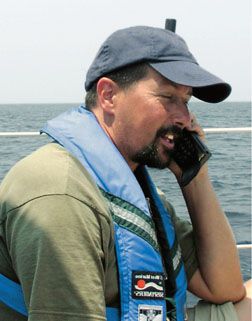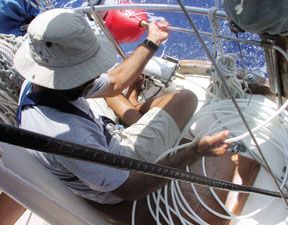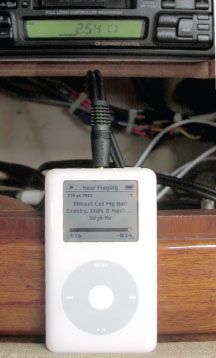
]By Scott Rosenthal
Last summer, we set out again aboard Willow, our 1980 Bristol 40 yawl, for our annual summer voyage. The trip — from Baltimore to the Turks and Caicos Islands via Bermuda, and then back to Baltimore — is a 3,000-mile jaunt that we covered in two months time. Trips like this can be a real proving ground for the boat and its equipment. This time we’re taking a second look at products we reviewed in the past, plus a couple of new toys for us, including an iPod.
Globalstar Satphone
In 2003, we used a Globalstar satellite phone on a trip to the far eastern Bahamas (PS May 15, 2004, “Globalstar Satellite Phone – Round One”). At that time, the phone worked, but not as well as we had expected, plus it was more expensive than we ever imagined.
This year we were ready for round two with Globalstar. We had kept the same phone from our previous testing. A major improvement for us was a pricing plan that allowed us to buy blocks of minutes instead of signing up for an annual program. Last time, we spent $872 on 929 minutes of calls. This cost included all activation fees, termination fees, taxes, etc., exclusive of the purchase of the phone. That cost worked out to a whopping 94 cents per minute. In addition to the cost, the voice and data connections were spotty and unpredictable.
Globalstar offers two different types of pricing plans: the Freedom plan and the Liberty plan. The Freedom plan works like a typical cell phone annual plan. The Liberty plan is different; it allows one to purchase a block of minutes with no monthly or termination fees. The only costs are for “long distance” phone calls. More on this later.
We bought for our two-month trip the Liberty 1800 plan, which gave us 1,800 minutes of air time that we could use for either voice or data. The plan’s price is $780 plus activation fees, taxes, etc. We received a $200 reactivation credit (we were former customers), which brought the price down to $580 and then we had added $95.65 in taxes, for a cost to us of $676. For most folks, the total would have been $876. Still, for 1,800 minutes, the cost would come out to 38 cents per minute (or 49 cents per minute without the reactivation credit), much better than two years ago.
The good news is that the voice phone service was much better than two years ago, when it seemed like you had to be a satellite specialist to get the phone to work. Now, it’s improved, but connection drop-outs are still common. We managed to have one 45-minute call without interruption, but 15 minutes was more typical of an uninterrupted connection time.
You can connect the Globalstar phone to a laptop and send and receive emails, and even surf the net if you can stand a less than 9600-baud connection. The email system was much improved over our last experience. While Globalstar may have improved its own workings, our previous experience also had taught us what to expect. Using the phone, we were able to stay in constant contact via e-mail with family and friends while at sea, in Bermuda, and in the Turks and Caicos.
We were also able to do real web surfing with the phone. We happened into the July from Hell when it came to hurricanes last summer. We had weatherfax capabilities, but the information isn’t updated very often and it’s only available certain times of the day. If you miss the broadcast, you’ve missed it. We were able to get on the National Hurricane Center’s website, download two or three pages of predictions, graphics, and a satellite photo in less than five minutes, anytime we wanted to. To us, that was very cheap reassurance that we were in a good, safe place.
Before leaving on the trip, we built a holder for the phone so that the antenna would point up for email connections without someone having to hold it. A 2”x4” scrap of wood, a ½” diameter PVC pipe, a couple of screws, a rubber band, and some black electrical tape gave us a holder that worked and also broke down easily for storage in the Ziploc bag with the phone. That, together with a six-foot RS-232 extension cord from Radio Shack, allowed us to sit at the nav station with the phone on deck under the dodger and successfully send/receive emails and do web browsing.
You need to test your system before taking off. Like before, our SMTP server for sending mail was not usable with the Globalstar system because of “authentication problems.” We’re not really sure what that means, but we used the SMTP server given to us last time by Globalstar and that worked fine (mail.uunet.ca). We were able to send attachments, but we found that they had to be under 100 Kbytes in size. Still, we were able to send a low-resolution photo from Bermuda and to receive a photo from our son’s band gig.
A very nice feature was being able to make local calls in the islands. VHF works fine short range and if the other party has a radio and it’s turned on. That’s not always the case in some places. Airplane schedule problems, marina issues at distant islands, medical problems at home — these real-life issues became easier to address with having the satellite phone aboard. Calling back to the US from each of these countries was a local call that just went against the block of minutes. Calls within the Turks & Caicos were billed at approximately 39 cents per minute, which we considered very reasonable.

We did have problems with the phone equipment. The week before we left, the GSP-1600 phone failed. We were testing it out and we couldn’t acquire a satellite. Nicely, Globalstar sent us overnight another phone and we returned the broken phone (plus a $200 exchange charge). While en route to Bermuda, the replacement phone failed. It failed to detect that the antenna was extended and therefore refused to work. If we worked at it and left the phone in the sun, it would work for a short while. We tried to get the phone apart to disable the antenna switch, but we didn’t have the proper size Torx driver. While the phone was working one time, we did manage to contact a customer service who told us how to use a business card to disable the antenna switch, which did work. We asked for another replacement phone to go our brother’s house, who was scheduled to meet us in Bermuda. It arrived at his house two months later than we planned. We don’t know what happened and neither did Globalstar, but the business card solved the problem.
Towed Water Generator
In 2002, we tested a towed electrical generator from Hamilton Ferris (PS February 15, 2003, “Towed Water Generator”). The unit consists of a deck-mounted generator, a 75 feet of line, and a propeller on the end of the line. You connect the line to both the generator and the propeller, put the line and propeller in the water, and the boat’s movement through the water turns the prop, which turns the line, which turns the generator, and makes electricity. The boat must be going faster than about four knots to make electricity. At about five knots, the system is making about one amp per knot of boat speed, which is exciting watching the knotmeter and ammeter moving up together.
As I wrote in 2002, the system works and is very quiet. The reduction in boat speed is minimal on our boat — probably about a tenth or two speed reduction. To us, this was very acceptable given the quietness of it and the fact that diesel was $6 per gallon in Bermuda!
We’ve learned from experience. Two years ago we were sailing from San Salvador to Conception Island in the Bahamas. We were towing the generator together with our dinghy for the 30-mile run. Our sons wanted us below so that they could be in charge. In the rolling conditions, no one noticed that the dinghy painter and towed generator lines had crossed. Eventually, the towed generator’s line chafed through and the line and prop disappeared into 6,000 feet of water. This year we purchased another line and prop from Hamilton Ferris for $286. This time no towing anything near that line.
It is very important to follow the instructions about looping the line off the stern and then putting the propeller in the water. If you just drop the prop in, the line twists and kinks. What a mess! It took two of us over 15 minutes trying to manhandle it over the stern. Then it took 30 minutes to untangle it. Afterward, we were tired, had rope burns, and we wet from all the exercise.
Also, it’s a good idea to where gloves when hauling the propellor in. Our friend Joe was retrieving the line one night and apparently, a Portuguese Man-of-War tentacle was wrapped on the line. Joe’s pain went away after couple of hours.
The second problem we had was sargasso weed fouling the prop. The weed would foul the prop, though not enough to stop it from rotating. Since the generator is so quiet, the only way we could tell that it was fouled was to monitor the current output from the generator or feel the temperature of the generator’s case.
Apple iPod
In 2000, we outfitted Willow with a 10-disc CD changer (PS March 2001, “Bahamas Log: How Things Worked”). The goal was to make it so easy to play non-repeating music. However, we found that the same CDs played over and over because no one would change the discs in the cartridge. This year, we decided try an Apple iPod to eliminate repeating the same songs over and over. What a great boat device.
We installed the iPod so that it played through the boat’s stereo system. We have an old automotive Sony cassette/radio unit that also connects to the CD changer. Through some simple wiring changes using Radio Shack audio cables we could play either the iPod or the CD player through the boat’s speakers using the Sony stereo. We had previously tried an FM transmitter from the iPod, but we couldn’t stand the tinny sound. We also installed a 12 volt cigarette lighter socket nearby to keep the iPod charged.

The iPod we used was the 20GB version. Before leaving, we had downloaded our entire CD collection on to it and there were 1,939 songs. We turned on the iPod at the beginning of the trip, put it on shuffle, and never turned it off until we reached Bermuda. If we didn’t want to hear music, we turned off the stereo but left the iPod playing. For those folks that are curious, it took us 6.4 days to reach Bermuda from Baltimore. During the trip, the iPod only started over once. In total, the trip took us a grand total of 2,157 songs to reach Bermuda.
The iPod took about 2 amp hours to keep it powered each day, which was not a lot compared to our daily usage of about 120 amp hours. The shuffle mode made for some abrupt transitions, but what a pleasure it was not hearing the same songs/CDs over and over again.
To our disappointment, the iPod eventually failed in the islands. It seemed as if the unit overheated. Songs would start skipping and then it wouldn’t play at all. As a test, we put it in the icebox in a Ziploc bag and it played fine from there. Once back home we sent the iPod back to Apple, who promptly replaced it. Hopefully we won’t have a similar problem next year after the warranty expires.
Rechargeable Batteries
In 2004, we evaluated AA batteries and the new Ni-MH rechargeables (PS, July 15, 2004, “Battle of the Rechargeables”). For our previous trips we routinely left with the following disposable alkaline batteries: 48 AA, 24 AAA, 20 C, 24 D, and three 9V. This time, we decided to try the 15-minute rechargeable batteries for the AA and AAA batteries. The experience worked wonderfully, but with some caveats.
We loaded up on the Rayovac I-C³ 15-minute rechargeable batteries together with the Radio Shack 23-039 12V charger. We replaced all the disposable batteries in our onboard devices (e.g., flashlights, handheld GPS, etc.) with rechargeables. We also brought along 20 AA and 4 AAA rechargeable batteries as spares.
Overall, we were very pleased with the battery lifetimes of the rechargeables. The original battery charge on our nighttime reading incandescent flashlight lasted the entire way to Bermuda. The handheld GPS also gave similar working time as the disposable batteries, though the lower battery voltages caused the low battery warning to appear even when plenty of charge remained. The 15-minute recharger worked well and did not put a large strain (about 1 Ah to charge four batteries) on the boat’s DC system.
There are limitations to the rechargeable batteries. Because of their inherent self-discharge characteristics, they are not very good in devices that aren’t used very often. Once we got back to Baltimore and were not using the boat daily, we found that the Ni-MH batteries were always generally low in power. For everyday use, we highly recommend the 15-minute rechargeable Ni-MH batteries. However, for infrequent usage (like a ditchbag), alkaline batteries are still the king.
Conclusion
We were pretty happy with all of the gear, but our experience also reminded us of the big difference between trying something in the store or at the dock and putting it to use at sea. Everything didn’t always go smoothly, but, in spite of the glitches (and outright failures), we feel that these are useful additions to many cruising boats, and will keep using them.
Also With This Article
“PS Value Guide: Cruising Gadgets”
Contacts
• Apple Computer, Inc. 408/996/1010, www.apple.com
• Globalstar 877/728-7466, www.globalstar.com
• Hamilton Ferris, 508/743-9901, www.hamiltonferris.com
• Radio Shack 800/843-7422, www.radioshack.com
• Rayovac 800/237-7000, www.rayovac.com
































